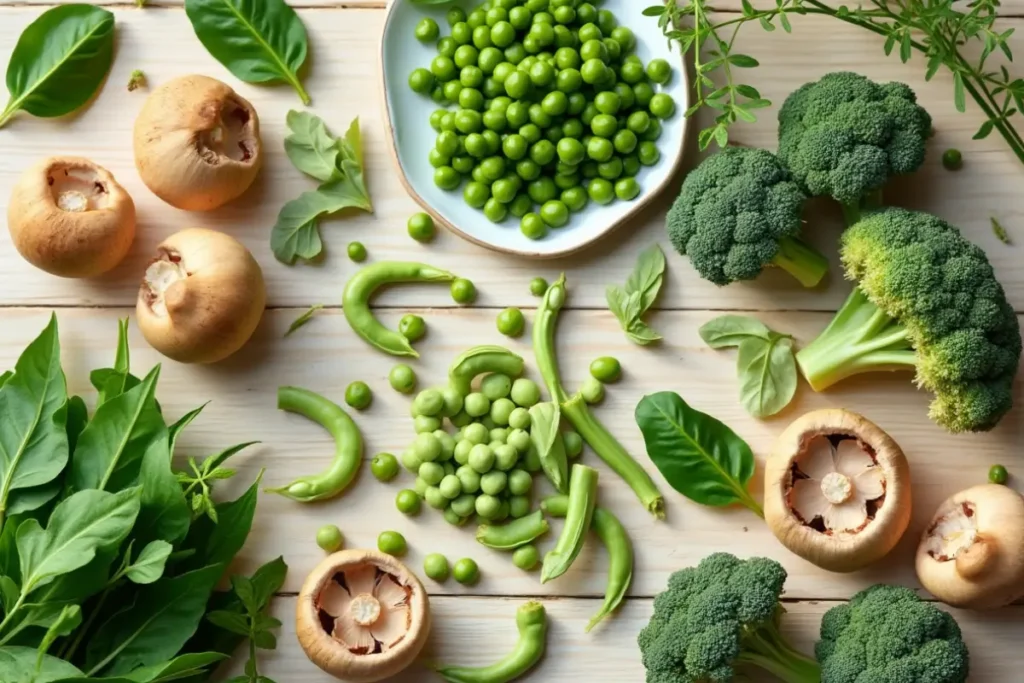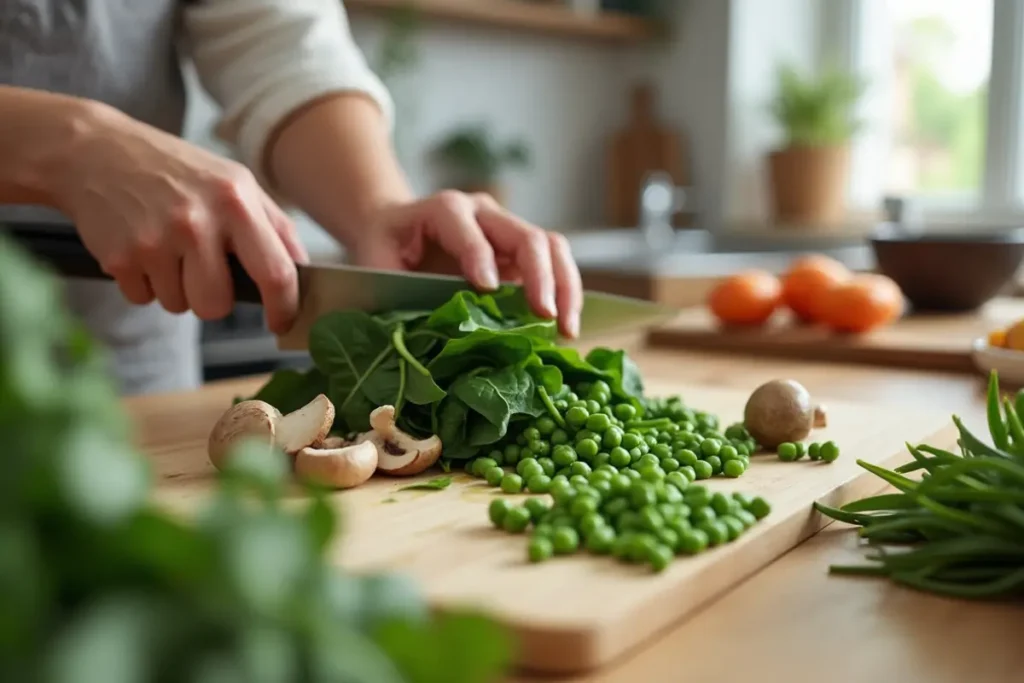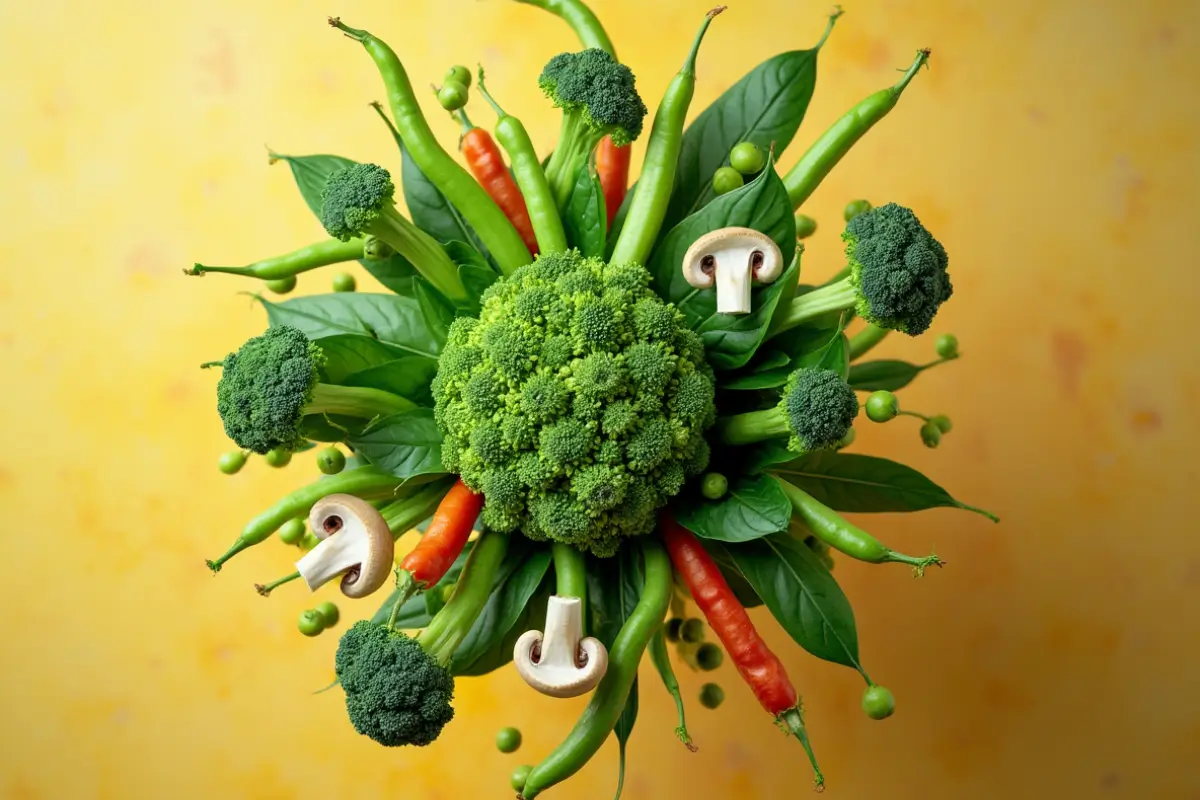Many of us, when we think about protein, often picture meat, milk, or eggs. Indeed, it’s a common idea that protein mainly comes from animals. However, what if I told you that plants, specifically vegetables, also have plenty of protein? You don’t actually need only animal products to get the protein your body needs. My journey into plant-based foods was a real eye-opener; in fact, the more I learned, the more surprised I was by the protein hidden in vegetables. So, get ready to change your thoughts about protein because we’re going to explore the amazing world of protein-packed vegetables.
The Importance of Protein and the Plant-Based Misconception
Protein isn’t just something fitness enthusiasts talk about; it’s absolutely essential for our bodies. Essentially, it’s like the construction team for your cells. Specifically, it helps build and repair tissues, it also creates enzymes and hormones, and it even keeps your immune system strong. Consequently, not getting enough protein can cause problems like weak muscles, tiredness, and slow healing. Therefore, it’s important to know that protein is a very vital part of our diet.
Now, the common misunderstanding is that vegetables are merely sources of vitamins and minerals, with little to no protein. However, this is simply not true. While it’s true that one vegetable doesn’t have as much protein as a steak, still, a varied diet with lots of plant sources can easily give you all the protein you need. Therefore, it’s about understanding which vegetables are good protein sources and how to use them. So, if you want to eat less meat, go plant-based, or just want more protein options, keep reading. You’re going to see how powerful plant-based protein actually is.
Top Vegetables Packed with Protein

Don’t believe that protein only comes from animals. The vegetable world actually offers many options that can significantly help you meet your daily protein needs. So, let’s focus on some of these often-overlooked protein stars. Indeed, these vegetables, commonly found all over the world, will demonstrate the range and wealth of plant-based protein.
Leafy Greens & Their Protein Punch
First of all, when we talk about vegetables, many people think of leafy greens. Usually, these green foods are praised for their vitamins and minerals, but their protein content is often missed. For example, did you know that spinach is actually more than just a source of Vitamin K, it’s also good for protein? Then, there’s kale, a favorite in the health world, which also contains both nutrients and protein. And finally, let’s not forget collard greens, another staple that provides a good amount of protein when cooked.
- Spinach: Approximately 5 grams of protein in one cooked cup. Moreover, it’s easy to add to salads, smoothies, and cooked meals. Additionally, its mild taste means it blends well with other foods.
- Kale: About 3 grams of protein per cooked cup. For best results, kale is best cooked to reduce its bitter taste. Also, it has lots of vitamins A, C, and K.
- Collard Greens: Providing about 5 grams of protein per cooked cup, they are known for their strong texture and slightly bitter flavor. You can boil, steam, or stir-fry them. Furthermore, they are used in many dishes worldwide.
Besides protein, these leafy greens also offer many other nutrients, like vitamins A, C, and K, folate, and various minerals. Therefore, they are an important part of any healthy diet. You can eat them in salads, steamed, or in a stew. So, these leafy greens are an easy way to increase your protein intake.
Legume-Vegetable Hybrids: Peas and Beans
Now, some of the best protein vegetables are actually legumes, which are cooked and eaten just like vegetables. For instance, green peas, edamame (young soybeans), and green beans fall into this group. They are not only delicious, but also great sources of plant-based protein.
- Green Peas: A cup of cooked green peas has about 8 grams of protein. While peas are often overlooked, they actually have lots of protein, fiber, and vitamins. You can eat them in soups, as a side dish, or in salads. Add them to rice cooker meals or enjoy them as a simple side dish.
- Edamame (Soybeans): This is a protein powerhouse, with about 18 grams of protein in one cooked cup. Also, it’s a complete protein, meaning it has all nine essential amino acids. Therefore, this is a fantastic plant-based protein choice.
- Green Beans: Although they have only about 2 grams of protein per cooked cup, they are still a great addition to your overall protein intake. Green beans are easy to cook, and are full of vitamins and fiber.
What makes these options especially good is their ease of use. In fact, you can easily add them to soups, stir-fries, salads, or even eat them as a side. Not only do they add to your protein intake, but they also give you key amino acids, which are important for many bodily functions.
The Mighty Mushrooms: Fungi Protein Sources
While mushrooms are technically fungi, they are frequently cooked and used like vegetables. Therefore, they give a unique taste and texture to foods, and, more importantly, are a good source of protein, especially if you want vegetarian options. Let’s look at some common types:
- Button Mushrooms: Providing about 3 grams of protein per cooked cup. These are very common and can be used in many different foods. For instance, they taste good with other vegetables and can be added to a salad or pasta.
- Oyster Mushrooms: Containing about 3 grams of protein per cooked cup. They have a light flavor and a soft texture. Additionally, they are great in stir-fries and soups. Furthermore, they add a special taste to your meal.
- Shiitake Mushrooms: With around 4 grams of protein per cooked cup, they are very flavorful and are often used in Asian cooking. You can use them in everything from soups to stir-fries. Besides that, they are also a good source of fiber.
Mushrooms also have antioxidants and other important nutrients. So, make sure you add them to your meals. For example, try adding them to soups, sauces, or grilling them for a simple, yet delicious meal.
Other Notable High Protein Vegetables
Besides the common vegetables, there are a few more hidden sources of protein. So, let’s take a look at these often-overlooked options.
- Broccoli: This vegetable has about 3 grams of protein per cooked cup. Also, it’s full of vitamins C and K. It’s one of the most useful vegetables. Try steaming, roasting, or stir-frying it. Add it to a high-protein breakfast to start your day right.
- Artichokes: Offering about 4 grams of protein per cooked cup, they are a good source of both protein and fiber. Moreover, they have lots of antioxidants. You can add these to salads or simply steam them.
- Asparagus: Provides about 3 grams of protein per cooked cup, along with vitamin K and folate. Its unique taste and texture will add a lot to your recipes. Try grilling, roasting, or stir-frying asparagus.
- Sweet Corn: Sweet corn offers 5 grams of protein per cup and can be a delicious addition to many dishes. Consider pairing it with shrimp creole for a balanced meal.
These vegetables, used in many different cuisines, show the variety and richness of plant-based protein. Moreover, they are easily added to your diet, and you can experiment with various cooking styles to make them even better.
Protein-Boosting Vegetable Recipes

Now that you know which vegetables have protein, let’s put that knowledge into practice. So, here are a couple of recipes to help you include these protein-rich vegetables in your daily meals. These are meant to be delicious and satisfying.
Hearty Green Pea Soup
This creamy soup is not only tasty, but also a great source of plant-based protein. It’s actually perfect for cold nights or when you need a warm, nourishing meal.
| Ingredients | Amount |
| Green peas | 2 cups |
| Vegetable broth | 4 cups |
| Onion | 1 |
| Garlic | 2 cloves |
| Carrots | 2 |
| Celery | 2 stalks |
| Olive Oil | 2 tbsp |
| Salt and Pepper | To taste |
Instructions:
- Heat the olive oil in a pot over medium heat. Then, add the chopped onion and cook until soft.
- Add the minced garlic, diced carrots, and celery, and cook for a few minutes until soft.
- Pour in the vegetable broth and bring to a boil.
- Next, add the green peas and turn down the heat. Cook until the peas are tender.
- Add salt and pepper to taste.
- After that, use a blender to blend the soup until smooth.
- Serve hot, topping with herbs if you like.
Spinach and Mushroom Stir-Fry
This stir-fry is fast, easy, and incredibly full of protein and nutrients, making it great for a quick meal. Furthermore, it’s easy to customize, so add any vegetables you want.
| Ingredients | Amount |
| Spinach | 3 cups |
| Mushrooms | 2 cups |
| Garlic | 2 cloves |
| Onion | 1 |
| Soy Sauce | 3 tbsp |
| Sesame Oil | 1 tbsp |
| Salt and Pepper | To taste |
Instructions:
- Heat the sesame oil in a pan over medium-high heat.
- Add the chopped onion and minced garlic, and cook until they smell good.
- Add the sliced mushrooms, and cook until soft.
- Afterward, add the spinach and stir-fry until it wilts.
- Pour in the soy sauce and stir to mix.
- Add salt and pepper to taste.
- Serve hot.
These recipes are just a starting point. Feel free to be creative, try new things, and make them your own. For example, add other vegetables or spices based on your preferences.
Maximizing Protein Absorption from Vegetables
Getting protein from vegetables is important, but also, it’s equally important to help your body absorb and use it. So, here are some key tips to help you use vegetable protein better:
- Combine with Healthy Fats: Consuming your vegetables with healthy fats, like those in avocado, olive oil, and nuts, can help your body absorb nutrients and use the proteins.
- Pair with Complementary Protein Sources: You can improve the amino acid profile of your vegetable protein by also eating it with other protein sources, like grains and legumes. Together, these proteins give your body all the essential amino acids.
- Choose Cooked over Raw (in some cases): Sometimes, some vegetables are easier to digest and give more nutrients when cooked. For instance, cooked spinach is easier to digest than raw spinach. Cooking can break down some molecules, making the protein easier to access.
- Pay Attention to Food Combinations: Likewise, how you mix different foods can affect digestion and nutrient use. For example, eating foods with iron, like spinach, with vitamin C, like bell peppers, helps your body absorb iron better. Similarly, mixing plant proteins helps improve their use.
By following these tips, you can make sure your body gets the best from vegetable proteins, making your plant-based journey better and easier.
Related Topics
By adding these high-protein vegetables to your meals, you can meet your nutritional needs while enjoying delicious and wholesome dishes. For more recipe ideas and tips, explore the recipes on Lay Recipes.
FAQs About Protein-Rich Vegetables
Here, are some common questions about protein-rich vegetables that you might have. Understanding these can certainly help you with your vegetable-based protein journey.
- Which vegetables are high in protein?
- Leafy greens (spinach, kale, collard greens), legumes (peas, edamame), mushrooms, broccoli, artichokes, and asparagus are good sources.
- Can you get enough protein from vegetables?
- Yes, a varied diet with protein-rich vegetables, grains, legumes, and nuts provides sufficient protein.
- Are vegetable proteins as good as animal proteins?
- While some plant proteins are incomplete, eating a variety throughout the day will provide all the essential amino acids.
- How do I increase the protein content of my vegetable-based meals?
- Use a variety of high-protein vegetables, combine them with grains and legumes, add healthy fats, and eat enough calories.
Conclusion
It’s time to change the idea that protein is only found in animals. The world of vegetables gives us lots of options that can help you with your daily protein needs. Indeed, vegetables are a great source of protein, and they are not just side dishes, but powerful sources of important nutrients. By changing your view and using more plant-based foods, you can greatly improve your health and help the planet.
By adding these protein-rich vegetables to your diet, you’ll enjoy many health benefits and also reduce how much you depend on animal products. Exploring plant-based protein is an exciting journey, and the rewards, from better health to new foods, are definitely worth the effort.
So, I encourage you to try the recipes mentioned earlier, or even create your own. Start using these high-protein vegetables in your daily meals, and you’ll surely be happy with their flexibility and how they help you have a healthier, more fulfilling diet. Therefore, let’s embrace the power of plant-based food, together.

